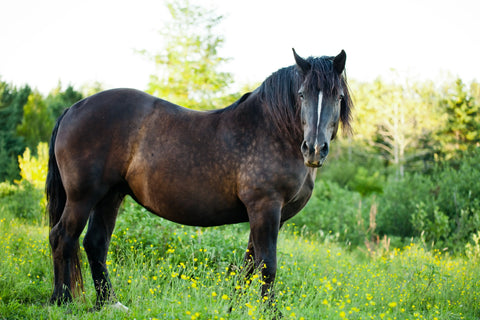
Albino Horse: Everything You Need to Know About This Unique Type
of reading - words
The Albino Horse (mare or stallion) has an immaculate white coat with pinkish skin and dark or blue eyes. Very friendly, robust and with great endurance, it is suitable for leisure equestrian activities such as riding (galloping or not). However, driving and show jumping are not really suitable for it, unlike the French saddle and the draft horse.
Where do albino horses come from?
In all animal breeds, the albino is recognizable through depigmented and red or pink skin, eyes with dark irises and a white coat. In equines in particular, it is subject to ambiguity. Indeed, the albino designates both a breed of horse and a horse dress.
Albino horse and albinism
Albinism comes from a recessive gene that an animal receives from both parents. The Albino color appears if each parent has passed on both copies of the gene. If this happens, it is simply a lack of pigment. Coat color is not affected by depigmentation if only one copy of the gene is passed on. It is therefore necessary to cross two albinos to produce an albino horse. However, this genetic principle does not apply in horse breeds.
In reality, the white coat is not transmitted by a recessive gene. Red or pink eyes have an iris without coloring. In addition, white horses have a white coat, blue or dark eyes, pink skin. The cream horse is not also an albino horse despite its pink skin and light eyes. It is said to be gray if its coat has a white appearance, black skin and dark eyes. Thus, it must be remembered that the albino or white horse is not the result of albinism.
Its true origin
All albino horses descend from the stallion called Old King, probably a riding horse of Arabian-Morgan origin. They may belong to the herd of Western Horses, a Quarter Horse, a Purebred Arabian or a Standardbred. American breeders have domesticated it in stud farms since the beginning of the 20th century, hence the name “American albino horse”. Through numerous crosses, they have managed to eliminate excessive sensitivity of the skin to the sun and blue eyes.
The characteristics of an albino horse
This is a light horse with a perfect silhouette and conformation. The albino horse generally has blue or dark eyes possibly showing a dilution gene. In equines with a champagne gene, the iris is characterized by progressive coloring. For example, foals have bright blue eyes that turn green as they grow. Once adult, their color increasingly resembles their coat (cream or amber). But also, albino horses can transmit certain physical characteristics determining a breed over several generations.
In short, the albino horse demonstrates intelligence and adopts a gentle temperament. It ranks among the most balanced and docile breeds of saddle horses. Its breeding just like its training can be done very simply.
Albino horse: not to be confused with other types of riding horses
In summary, an albino horse has an entirely white color (neck, trunk, mane, head, mane and limbs) which does not change with age. It has pink skin and pink or red eyes. This type of horse can produce a completely white foal. However, there are types of horse that have the characteristics of an albino, but are not really an albino. Here they are!
The gray gene
The graying of the horse is a gradual discoloration of the basic coat (chestnut, bay or black) with which the equine was born. For example, the chestnut or bay coat fades over the years to become gray and ultimately almost white. At this stage, the gray horse takes on the appearance of an albino horse. To differentiate them, just notice the skin color. According to the studbook, the gray gene is present in most breeds, especially those which come from the purebred Arabian, the purebred Spanish (originating from the Andalusian territory), the thoroughbred and the Lusitano.
The cream horse
Known by the misnomer of albino, the cream horse adopts a white dye at double dilution. The cream genes inherited from both parents act on a chestnut base and dilute the coat to cremello, a pale, golden color that easily blends with white. In addition, with blue eyes, the cream horse is immediately assimilated with the albino horse. The absence of dark pigment and red eyes distinguish the albino from the cremello.
The Pinto horse
From the breed of Frisian horse, the pinto horse wears a piebald coat or splashed patterns. Pinto is not really a color. This is a color modifier that removes pigment on certain surfaces of the horse. The depigmented area generally takes on a large extent which can go so far as to completely cover the body of stallions or mares.
The balzan magpie
The piebalzan is a variation of the pinto pattern and often compared to an albino horse. The piebald pattern starts from the legs and goes up towards the belly. The white splattered patterns leave noticeable marks on the face and can even take over the entire head. In its most serious form, piebalzan causes hearing loss in horses and eliminates color from the back to the rump.
Symbolism and usefulness of the albino horse
With a height at the withers below 1.40 m, the pony becomes more suitable for child-friendly riding. With a white dress, it can only be attractive. It’s the same with albino equines (saddle horse or sport horse). Indeed, the albino horse allows the novice or expert rider to indulge in a more exciting equestrian activity. In addition to being attractive, it has a particular importance thanks to the symbolism attached to it since the dawn of time: anti-spell, good luck charm, vehicle of divinities and heroes, etc.









